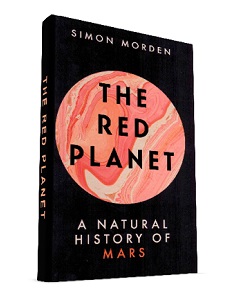If you are looking for an attractive picture book about Mars, containing the latest renderings of the Martian surface from our ‘eye-in-the-sky spaceprobes’, this is not the book for you.
However, if you like the sound of an “enthralling narrative journey through the history and geography of Mars”, this could be worth a punt, especially at a cover price that won’t break the bank.
Arguably, the most engaging aspect of this book is the author’s background as a planetary geologist and geophysicist…and award-winning science fiction writer. This makes the volume at the same time both readable and authoritative. In common with many other authors, Simon Morden “realised he was never going to get into space and decided to write about it instead”. Of course, this doesn’t qualify him as a good writer, but he is.
The book itself is divided into seven parts that introduce the red planet, describe its formation and detail the three time periods (Noachian, Hesperian and Amazonian) that characterise the planet’s development. There is also a bibliography and an index.
There is no attempt to obfuscate here, despite the unusual names and terminology; in fact, the author prides himself in making his subject interesting and accessible. And on the subject of the ‘missing illustrations’, their lack is amply replaced by the author’s descriptive talents: “It’s cold. So cold that the frost glittering on the rocks has been wrung out of the air itself…”; “The landscape is flat: not sheet flat, but plains flat, Badlands flat”; “The distance to the horizon is an illusion you’ve not yet got used to”.
In the final chapter, he briefly discusses the ethics of developing Mars – from mining to terraforming – but reaches no firm conclusions. He does, however, state that this is “a debate that we have to have at the beginning of the process, not after it’s under way” and, in that opinion, he will find many supporters.











